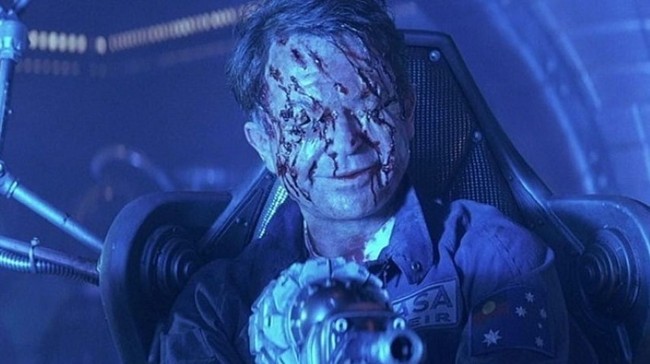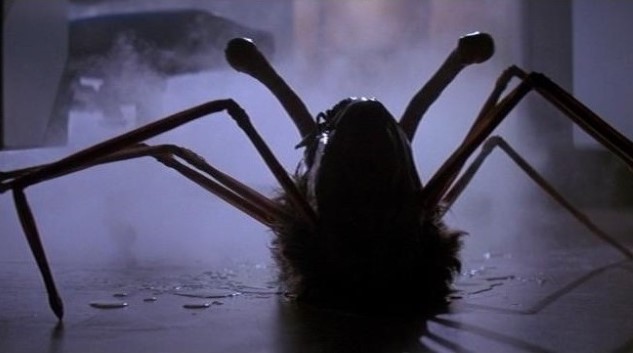The 20 Best Lovecraftian Horror Movies
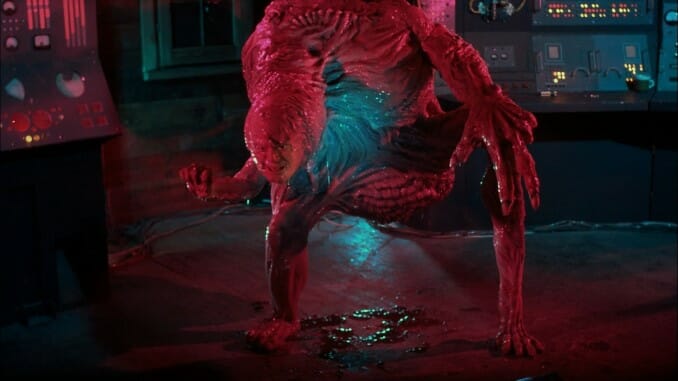
It’s sort of odd to think that when I first began reading the cosmic horror fiction of author H.P. Lovecraft in the early 2000s, the man was still considered a fairly obscure figure in American pop culture, if not literary history. Horror fiction devotees could have told you about Lovecraft’s pantheon of elder gods and otherworldly beings at that point, but the average cinemagoer had little to no familiarity at the time with any of them, Cthulhu or otherwise. Nobody was seeking Lovecraftian horror movies. Some 20 years ago, the collected works of H.P. Lovecraft were still the stuff of deep nerd cliché, a sort of “secret handshake” among horror geeks and 1980s horror movie buffs.
A few decades later, awareness of the author’s life and his most famous creations has been utterly transformed, and the average person walking down the street now has a good chance of recognizing the name “Lovecraft,” or even that of Cthulhu. This should perhaps not be a big surprise—after all, this same period has seen the average person go from being dimly aware of only a handful of Marvel superheroes, to likely being able to recite the names and powers of dozens of them, and our biggest Hollywood blockbusters revolve entirely around geek material that was once the stereotypical stuff of poor losers being walloped by cinematic bullies. That which was once the warren of outcast nerds has been almost completely absorbed into the mainstream, and this includes the more obscure corners of the horror universe. Perhaps in that sense, it was inevitable that entire episodes of South Park would eventually revolve around Lovecraft jokes, and that plush Cthulhu dolls would proliferate online.
If there’s one place that Lovecraft and his cosmic horror ideals have always been at home, though, it’s been in cinema. Since the Stuart Gordon-driven heyday of bizarre Lovecraft adaptations in the 1980s, to modern indie horror, the author’s themes of cosmic terror and man’s insignificance in the universe have persevered and become reference points for the genre as a whole. Along the way, “Lovecraftian” has become one of the genre’s most oft-cited (and frankly overused) adjectives, implying as little as “contains tentacle monsters” to some, while hinting at profound cosmic truths to others. In our eyes, Lovecraftian horror films are all about peeling back the veil that separates reality from the realms of madness, and watching characters deal with the resulting shock to their central nervous system.
Here, then, is a celebration of 20 of the best Lovecraftian horror movies to be found out there. Some are literal adaptations of Lovecraft stories, or loosely inspired substitutes. Others are clear tributes to the man, and his impact on American weird fiction. Still others simply evoke the ideas of cosmic horror with which Lovecraft is so closely and permanently affiliated. All make for great watching, especially in the Halloween horror season.
Lovecraftian horror honorable mentions: AM1200, Chilean Gothic, Dreams in the Witch-House, Cool Air, Bride of Re-Animator, The Unnameable, The Unnamable II: The Statement of Randolph Carter, Pickman’s Muse, Cthulhu (2007), Black Site, Cast a Deadly Spell
Annihilation
Year: 2018
Director: Alex Garland
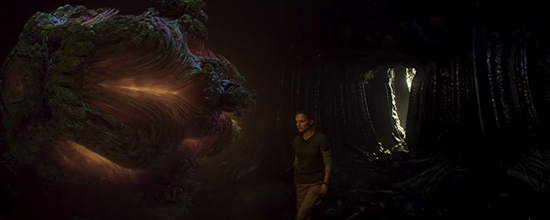
Alex Garland’s meditative adaptation of Jeff VanderMeer’s novel Annihilation is perhaps not the first film you’d immediately associate with “Lovecraftian” horror, but it actually fits the descriptor quite well. The “Shimmer” itself seems deeply indebted to Lovecraft’s 1927 story “The Colour Out of Space,” itself adapted as another entry on this list. As in Lovecraft’s story, Annihilation sees a mysterious force of extraterrestrial origin fall to Earth, where it leeches into the countryside and begins to transform and warp reality around it, with one of the leading indicators being the otherworldly colors and visual distortion that spreads from the epicenter of what is essentially an alien infection. Annihilation takes a studious, philosophical perspective on the ramifications of entering such a zone, as biology grapples with the inherent spark of identity and humanity within all of us—it’s perhaps a bit more cerebral than many of Lovecraft’s works, but the influence is unmistakable.
In particular, the film’s ultimate depiction of the extraterrestrials strikes a very appropriate tone for Lovecraft, in the sense that the alien intelligence is portrayed as truly alien, rather than as human in some other guise. The consciousness encountered by the characters here is genuinely unknowable, totally outside of our capacity to grasp, which reinforces the Lovecraftian tenet of humanity’s extremely meager understanding of our reality, and relative insignificance in the cosmic scheme of things.
The Call of Cthulhu
Year: 2005
Director: Andrew Leman
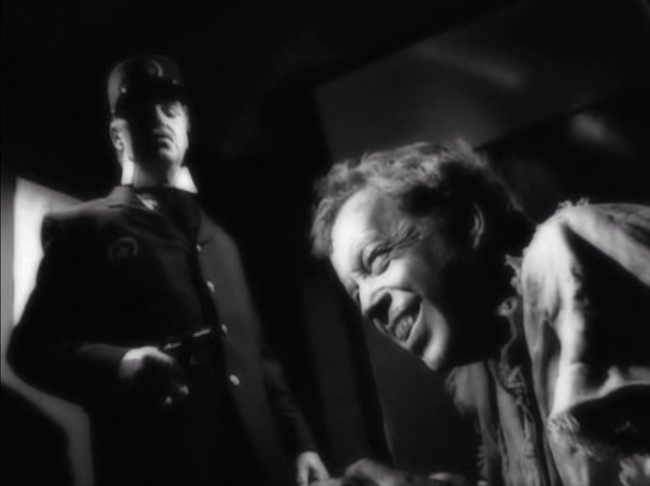
Some of the most famous Lovecraft stories have often been considered the author’s most unfilmable works, in part because of their unconventional structures and propensity for suggestion rather than outright description. A story like Lovecraft’s iconic “The Call of Cthulhu” was never written with filmic adaptation in mind, and indeed it never stood a chance of being adapted into a film while the author lived, as he was almost completely unknown outside of “weird fiction” circles. Moreover, the largely epistolary style of the original story makes even a modern adaptation into a fairly complex challenge.
Producers Sean Branney and Andrew Leman deserve all the more credit, then, for their brilliant use of vintage filmmaking techniques to finally create an adaptation of “The Call of Cthulhu” in a way that captures not only the tone of the story but the style of Lovecraft’s own heyday. Shot in a process they dubbed “Mythoscope” and distributed by the H.P. Lovecraft Historical Society, The Call of Cthulhu blends modern and vintage filming techniques to adapt the story as a 1920s-style silent horror featurette. In doing so, Branney and Leman essentially reimagined an alternate reality in which Lovecraft’s fiction was embraced in the 1920s as it has been today, resulting in a film that translates the principles of cosmic horror to the same dramatic era that gave us the likes of Nosferatu and The Cabinet of Dr. Caligari. What the team achieved is utterly charming, perhaps the most affectionate tribute that the Lovecraftian horror genre has ever seen, and a model for other aspiring filmmakers to stretch the boundaries of how these stories could potentially be adapted in the future.
Castle Freak
Year: 1995
Director: Stuart Gordon

This is the first entry on the alphabetically ordered list from prolific H.P. Lovecraft fan Stuart Gordon, but it will by no means be the last. It also demonstrates what Gordon would more or less make his signature technique in adapting the works of Lovecraft, which is to loosely adopt the general outline or a specific element of a story, while subsuming those elements into a format that was already popular—gory, 1980s-style pulp horror. Suffice to say, strict adherence to Lovecraft’s work was not Gordon’s way as a director. Rather, he had an eye for what would be marketable, although he at least drew more direct inspiration from the author than the likes of Roger Corman did from Edgar Allan Poe.
Castle Freak is loosely based on the Lovecraft story “The Outsider,” in which a man who has been imprisoned in a cell for his entire life breaks free in a pitiable effort to connect with others, only to find that society views him as a monster. Gordon’s film, on the other hand, simply swaps this into more of a monster movie/slasher vibe, making the obvious viewpoint characters into the people encountering the titular castle freak. There are some other appropriately Lovecraft touches, however—Jeffrey Combs as the “last living relative” of the family who originally owned the castle is a particularly Lovecraft-like bit of plotting, given the author’s obsession with genealogy and how the sins of the past carry through generations in an almost genetic way.
Color Out of Space
Year: 2020
Director: Richard Stanley
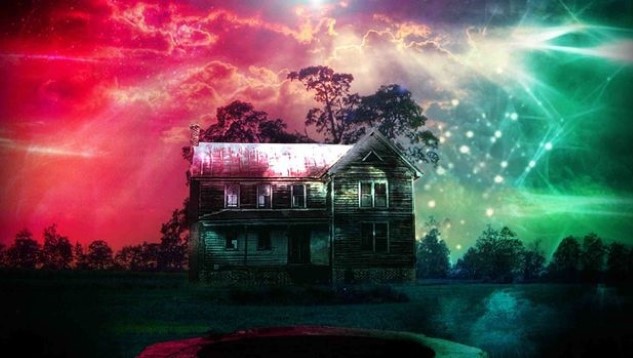
“The Colour Out of Space” is one of the Lovecraft stories that has been adapted most frequently over the years, perhaps because its plotting is significantly more linear and conventional to depict—a meteorite falls from the sky near a country home, and a family soon begins to feel the effects of the mysterious “color” it emits, which mutates and warps reality around it. As we wrote of the film last year:
Lovecraft imagined his personal fears—particularly of “the masses”—into wholly unimaginable entities, his work so tethered to his pants-wetting neuroses that adapting it for a visual medium feels like a masochist’s chore. That makes Richard Stanley perfect for translating Lovecraft’s short story “The Colour Out of Space” into a feature-length film: The last time he tried making a horror movie it was 1994, and the feature was The Island of Dr. Moreau. Turning Lovecraft’s words into coherent cinema is a comparative walk in the park, and in Color Out of Space, Stanley gaily strolls ahead with a palette sporting every shade of purple, adding splashes of phlox here and smears of thistle there before coating the screen entirely in heliotrope hues by the end. “Color” is the key word of the movie’s title and the most important tool in Stanley’s work belt: The longer the horror Lovecraft describes on the page endures and infects the world around it, the more vivid Stanley’s imagery becomes. The second most important tool, perhaps expectedly, is Nicolas Cage, starting off the 2020s on the right foot with another Cage-ian horror performance after his stellar work in 2018’s Mandy. If there’s an actor better-suited than Cage for conveying the experience of losing one’s sanity under Lovecraftian duress, the industry hasn’t found them yet. Cage, like Stanley, occupies an existential plane visited by no one else. Lovecraft’s words give Color Out of Space a foundation; Cage gives it character. He might exist in a vacuum, but he doesn’t act in one: The rest of the cast falls in the orbit of his unhinged eccentricity, much as the meteorite’s presence warps all nature around it. Cage, by being Cage, makes everyone around him better, or if not better, then stranger. —Andy Crump
Dagon
Year: 2001
Director: Stuart Gordon
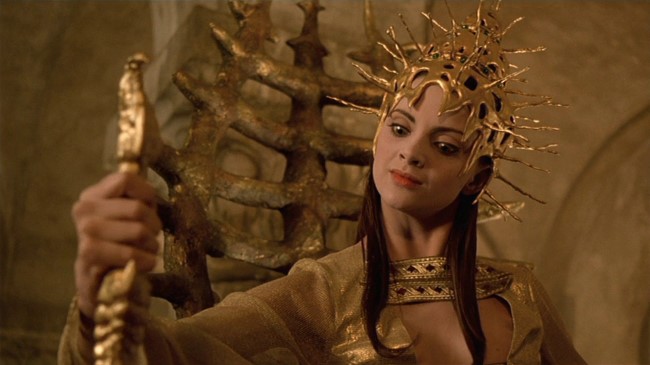
“The Shadow Over Innsmouth” is another Lovecraft story that has been adapted on multiple occasions, although it’s never received the big-budget (or even mid-budget) treatment one could probably give it to faithfully tell one of the author’s more straightforward and film-friendly plots. This go, one of Stuart Gordon’s later Lovecraft adaptations, cribs the title “Dagon” from an earlier Lovecraft story of the same name, but in every way that matters it’s inspired by “The Shadow Over Innsmouth,” another tale about the horrors of genealogy, fate and predeterminism vs. free will.
The results are a wildly uneven array of Lovecraftian highlights, with some frenzied, over-the-top performances (especially by the scene-stealing, exceedingly intense Macarena Gómez) that are lifted by the excellent location shooting and genuinely spooky set pieces. The FX, on the other hand, shows the great limitations of Gordon’s limited budget, but the film isn’t stingy with its monster action … even when perhaps it would have been more effective to suggest rather than to overtly show. Still, you can feel Gordon’s enduring passion for his work throughout, even if his access to quality filmmaking tools has clearly waned by this point in his career. It’s a lesser Gordon entry, but one that is harmlessly campy fun.
The Dunwich Horror
Year: 1970
Director: Daniel Haller
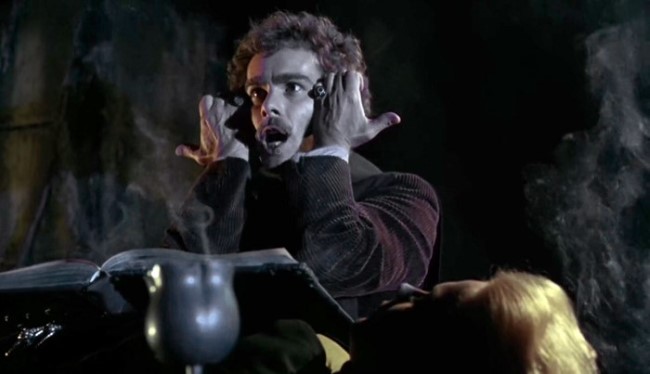
This is a fascinating entry on the list, in the sense that it comes from an era when the Lovecraft name had essentially no marketing cache of any kind, nor were the films free to depict the more gonzo aspects of Lovecraftian horror that would become more common in the 1980s. The Dunwich Horror therefore stands alone as something of an oddity—the only really legitimate attempt at adapting a decently budgeted Lovecraft story (of the same name) in this time period, predictably constrained by its late 1960s Hollywood trappings.
The screenplay for this film plays fast and loose with Lovecraft’s “The Dunwich Horror,” inserting Sandra Dee of all people as a college student ingenue who is both drugged and seduced as she is coaxed into a family of Lovecraftian antagonists who (as ever) have been sticking their noses where they don’t belong, cosmically speaking. Their attempts to reawaken ancient, celestial gods is pretty stock-standard stuff for Lovecraft’s arcana, making the things that ultimately stand out about The Dunwich Horror the impressively lavish set design and the less-than-effective and painfully dated costuming. There’s an attempt being made here to insert a bit more dark romance and even a bit of sensuality into the story, but these concepts tend to clash with the dispassionate and cold approach Lovecraft typically preferred. The film feels very much like the product of a Hollywood system that wanted to gauge the Lovecraft name as a selling tool, rather than people with any great reverence for his writings.
Event Horizon
Year: 1997
Director: Paul W. S. Anderson
It’s weird to think that Paul W.S. Anderson, the auteur of shitty, big-budget videogame adaptations (not to mention 2011’s The Three Musketeers) was also the director of one of the more imaginative sci-fi horror films of the ’90s, but it’s true. Event Horizon follows a rescue crew boarding a derelict experimental ship that they learn has traveled between dimensions—and suffice to say, it hasn’t been to friendly places. The evil presence on the ship then tests all the crew members with disturbing visions of the beyond, succeeding in possessing the ship’s designer, played by Sam Neill. This gives you the best, craziest aspect of the film; a Sam Neill villain who has gouged his own eyes out, melodramatically lecturing members of the crew about how he’s going to take them all back to the hell dimension straight out of H.P. Lovecraft’s darkest nightmares. Neill is seriously way over-the-top in this one, and it’s simultaneously funny and scary and gross as hell, while seemingly being a clear inspiration on future videogame franchises such as Dead Space. —Jim Vorel
From Beyond
Year: 1986
Director: Stuart Gordon

From Beyond might actually be one of the most spiritually authentic attempts Stuart Gordon made in adapting the works of Lovecraft—he ignores the setting of the original story, but the basic plots and themes are preserved quite faithfully. It asks a simple question: What if a scientific breakthrough allowed us to see into another world, only to find the denizens of that world looking right back at us? Like so many other Lovecraft stories, it posits the possibility that it’s only our relative ignorance and insignificance that is protecting the human race in the grand scheme of things, and that if we advance enough to draw the interest of higher lifeforms, that will ultimately be our undoing.
From Beyond also most definitely feels like a spiritual sequel of sorts to Gordon’s own Re-Animator from a year earlier, with both Barbara Crampton and the incomparable Jeffrey Combs returning for another gory go-round. Combs’ character here doesn’t quite have the haughty, imperious antihero energy of a Dr. Herbert West, but he still brings the goods playing more of a straight man who witnesses his mentor transformed into a hideous, shapeshifting creature. Like most Gordon movies of this era, it’s distinctly gross, with gooey sci-fi practical effects that still hold up nicely today.
Glorious
Year: 2022
Director: Rebekah McKendry
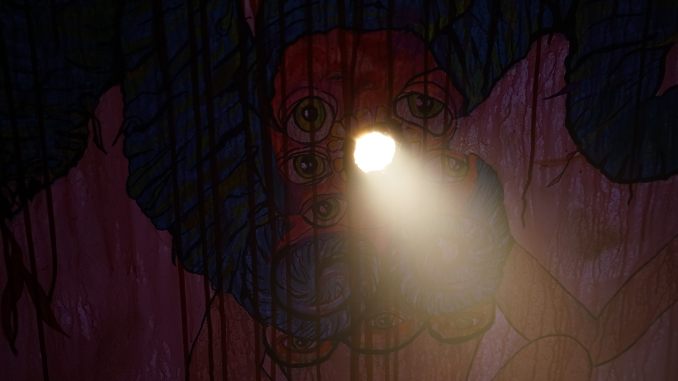
Glorious would completely fall apart were it left to an actor who was not up to the challenge, but Kwanten nails it. Given that he is only ever acting against a bathroom stall or his own reflection, it is impressive that he is able to carry the audience through the many emotional pivots Wes goes through in 79 minutes. We do not have a lot of time to get to know him before the tension escalates, and Kwanten’s performance makes sure we never miss a single beat of his suffering or frustration. Where Glorious stumbles a bit is in the mythology it hopes to create. From early on it is evident that there are greater forces at play, and whatever is talking to Wes is just easing him into the enormous world of its making. There are clear nods to Greek mythology and Lovecraft’s visions of the elder gods, but it feels more like a collage of random elements than the creation of a cohesive, reimagined mythology. Much like the graffiti on the bathroom walls, it is a collection of Easter eggs, not a single sweeping mythos. The allusions are fun to identify, but it feels like a missed opportunity to create a truly defined experience for Wes and this voice. Given its limited cast, location and budget, Glorious is an impressive feat. It never drags or feels more claustrophobic than intended. Thanks to strong performances and mostly tight writing, it’s a tense little chamber film, with deities and grand ideas, but without pants. —Deirdre Crimmins
The Haunted Palace
Year: 1963
Director: Roger Corman
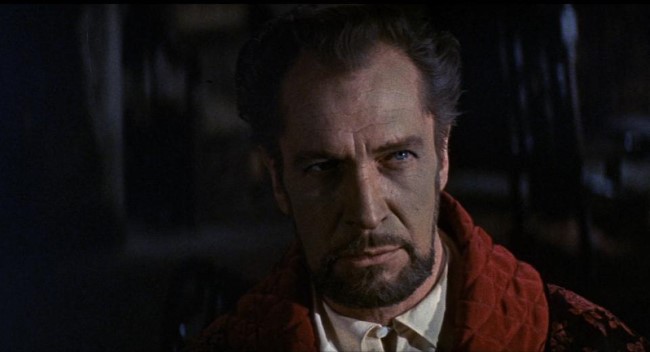
Genuinely one of the finest films ever personally directed by B-movie kingpin Roger Corman, The Haunted Palace has an unusual air of sophistication and opulence in comparison with most of the films of Corman’s career—it’s clear that he’s working with a significantly bigger budget than usual, and he makes the most of it. The film came toward the end of the director’s so-called “Poe Cycle,” in which he was adapting Edgar Allan Poe Stories such as “The Fall of the House of Usher” and “The Pit and the Pendulum,” which led to the ever-resourceful Corman titling this movie after Poe’s poem “The Haunted Palace,” even though it’s actually a straight-up adaptation of H.P. Lovecraft’s novella The Case of Charles Dexter Ward. This being the first big-budget adaptation of a Lovecraft work, it’s understandable why Corman assumed the name would have no marketing power.
As for its execution, The Haunted Palace benefits greatly from some opulent set dressing and a classically spooky feel, being not far off from some lost American addition to the Hammer horror canon. Its greatest tool, however, is the presence of the iconic Vincent Price in its lead role as Charles, a man who travels to an ancient ancestor’s castle and finds himself slowly falling under the spell of centuries-old witchcraft. Reflecting the author’s common themes of genealogy and the corrupting influence of evil blood, The Haunted Palace becomes unmistakably Lovecraftian in short order.
In the Mouth of Madness
Year: 1994
Director: John Carpenter
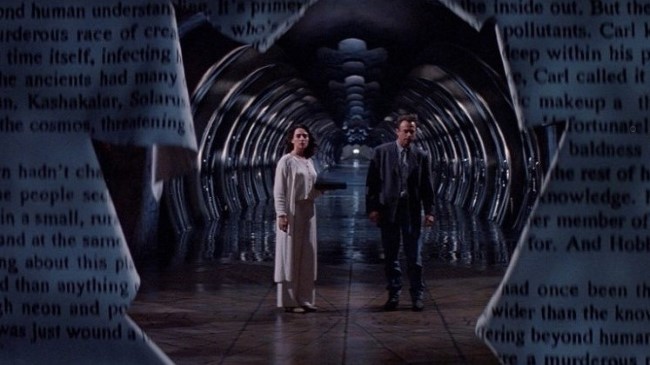
Stephen King may be the horror author overtly namechecked, but In the Mouth of Madness is much more directly John Carpenter’s tribute to the pioneering weird fiction of author H.P. Lovecraft, to the point that the film is almost a collage of Lovecraft’s greatest hits—interdimensional elder gods, parallel dimensions and Things Too Horrible to Describe. There’s no overt Cthulhu appearance, but there might as well be, as demented author Sutter Cane presents like one of the romanticized pop culture representations of Lovecraft as tortured genius (in addition to counter-criticism of his racist writings) that have become more common in the last few decades as the writer’s works have steadily been absorbed into the mainstream. Carpenter’s tribute seems to presage the mainstreaming of weird fiction and cosmic horror itself, and you have to wonder what the director thinks today of the visibility of Lovecraft as a genre, and indeed a verb, almost 30 years later.
Regardless, In the Mouth of Madness stands out when rewatching today for its grasp of the dreamy, almost Lynchian crossing of boundaries between the mundane and the extraordinary.
Necronomicon
Year: 1993
Director: Brian Yuzna, Christophe Gans, Shusuke Kaneko
![]()
The concepts of ancient, celestial elder gods or Old Ones such as Cthulhu are the concepts most frequently tied back to Lovecraft and regurgitated in the horror genre at large to this day, but there are also specific bits of ephemera introduced by the author that have been depicted just as many times on screen, or more. Of these, perhaps the most famous is the fictional book The Necronomicon, the so-called “book of the dead” featured heavily in the likes of Evil Dead and beyond. Bearing a catchy title and just the right-sounding air of menace, The Necronomicon has become such a frequent reference that many have mistakenly believed it to be a real publication over the decades.
Clearly, this was also perfect material for a horror anthology, as “stories out of the pages of the Necronomicon” is a concept that practically writes itself. Frequent Stuart Gordon collaborator Brian Yuzna (he also wrote Honey, I Shrunk the Kids, if you can believe that) takes the lead on this scattershot but well cast trio of stories, filming both the wraparound segments and the first story “The Drowned,” loosely based on Lovecraft’s “The Rats in the Walls.” The stories aren’t always the most sensible, but they’re all FX bonanzas, which makes them deliriously entertaining. Also wonderful is the presence of Jeffrey Combs once again, this time literally playing H.P. Lovecraft himself in the wraparound segments. It’s truly an inspired choice, and one that makes Necronomicon one of the most loving of adaptations of the author’s work.
Re-Animator
Year: 1985
Director: Stuart Gordon
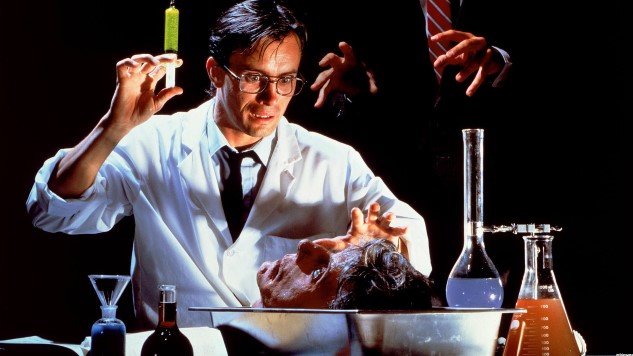
Ironically, the most entertaining take on H.P. Lovecraft is one of the least “Lovecrafty.” Stuart Gordon established himself as cinema’s leading Lovecraft adaptor with a juicy take on the story “Herbert West, Re-Animator,” about a student who concocts a disturbingly flawed means of reviving the dead. Re-Animator more closely resembles a zombie film than Lovecraft’s signature brand of occult sci-fi, but it boasts masterful suspense scenes, great jokes and Barbara Crampton as a smart, totally hot love interest—i.e., it’s a near-perfect ’80s horror movie. Jeffrey Combs as West is brilliant, establishing himself as the Anthony Perkins of his generation, a hilariously insolent and reckless genius whom he played in two Re-Animator sequels. The actor even played Lovecraft in the anthology film Necronomicon. The film is a near-perfect crystallization of best aspects of ’80s horror, from its delight in perversion to its awesome practical effects. —Curt Holman
The Resurrected
Year: 1991
Director: Dan O’Bannon

The Case of Charles Dexter Ward is one of the Lovecraft novellas that has seen multiple adaptations, appearing on this list twice, although at least by 1991 it wasn’t in the context of being disguised as an Edgar Allan Poe story. Instead, this time around it came courtesy of Alien writer and Return of the Living Dead director Dan O’Bannon, although sadly The Resurrected doesn’t come anywhere near those iconic horror classics. In fact, one might even make the case that Corman’s The Haunted Palace was a little bit more faithful to the structure of Lovecraft’s story, although this version is certainly far more modern and grotesque.
In place of Vincent Price, we have Princess Bride douchebag and Jack Skellington voice artist Chris Sarandon in this installment, playing the ill-fated Charles Dexter Ward, a man who learns of a terrifying family history that sees him become obsessed with the paranormal and the powers of necromancy. The story has more of a mysterious vibe in this telling, a supernatural detective tale that evokes protagonists from Lovecraft stories such as “The Shadow Over Innsmouth.” The FX, meanwhile, feel like a lesser effort from Stuart Gordon, but there’s not quite as much manic energy as the best of the Gordon/Yuzna collaborations. Only Sarandon’s performance and the sober tone make the film stand out among other Lovecraft adaptations.
The Ritual
Year: 2017
Director: David Bruckner

A prime example of what might be termed the “bro horror” subgenre, The Ritual’s characters are a band of lifelong mates united in mourning a friend who has recently been killed in a brutal liquor store robbery. Luke (Rafe Spall) is the member of the group who shoulders the greatest burden of guilt, being the only one who was in the store at the time, paralyzed with indecision and cowardice while he watched his friend die. The other members clearly blame Luke for this to varying degrees, and one senses that their decision to journey to Sweden for a hiking trip deep into the wilderness is less to honor their dead friend’s memory, and more to determine if their bond can ever be repaired, or whether the recrimination stemming from the death is insurmountable. Where The Ritual excels is technically, in both its imagery and sound design. Cinematographer Andrew Shulkind’s crisp images and deep focus are a welcome respite from the overly dark, muddy look of so many modern horror films with similar settings (such as Bryan Bertino’s The Monster), and the forested location shots, regardless of where they may have been filmed, are uniformly stunning. Numerous shots of tree clusters evoke Celtic knot-like imagery, these dense puzzles of foliage clearly hiding dire secrets, and we are shown just enough through the film’s first two thirds to keep the mystery palpable and engaging. Director David Bruckner, who is best known for directing well-regarded segments of horror anthologies such as V/H/S, The Signal and Southbound, demonstrates a talent here for suggestion and subtlety, aided by some excellent sound design that emphasizes every rustling leaf and creaking tree branch. Unfortunately, the characters are a bit thin for what is meant to be a character-driven film, and the big payoff can’t quite maintain the atmosphere of the film’s first two acts. Still, The Ritual is a great-looking film, and one that features one of the more memorably “WTF!” monster designs (a truly disturbing Lovecraftian beast) in recent memory. It’s worth a look for that alone. —Jim Vorel
Sacrifice
Year: 2020
Directors: Andy Collier, Tor Mian
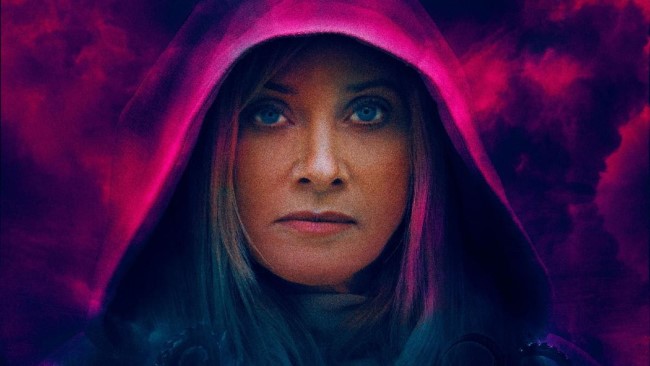
In modern indie horror, “Lovecraft” has long since become its own prolific subgenre, with numerous would-be auteurs taking their crack at cosmic horror, tentacle beasts and everything else they think “Lovecraftian” entails. These types of films have essentially become a dime a dozen in the last decade, though the likes of Sacrifice still stand out as a cut above, relatively speaking, for their sharp production values and absolute commitment to the Lovecraftian theme. Sacrifice is unsurprisingly buoyed immensely by the veteran presence of Barbara Crampton, the queen mother of Lovecraft adaptations, still in the midst of the same career resurgence that has seen her star in other indie horror films like We Are Still Here and Jakob’s Wife.
The plot of Sacrifice will no doubt strike the Lovecraft-aware as very familiar, being assembled almost entirely from tropes rather than any specific one of the author’s stories. The remote seaside town calls to mind “The Shadow Over Innsmouth,” while the slumbering god and his cult are obvious stand-ins for Cthulhu. There’s also the frequent Lovecraft themes of cursed genealogy and occult ceremony, all of which make Sacrifice feel a tad rehashed. Still, its execution is slick, and its implications suitably icky. As long as we still find Lovecraftian horror spooky, new versions of this familiar story will keep getting made.
Spring
Year: 2014
Directors: Justin Benson, Aaron Moorhead

One of the only vaguely Lovecraftian horror films that can also be described with the word “romantic,” Spring is something truly unusual and individualistic. That’s nothing new for directorial duo Benson and Moorhead, who have made a collective name for themselves with mind-bending and philosophical horror films that play with the nature of reality, such as Resolution and The Endless. Spring, on the other hand, is less concerned with fate, predestination and the conventions of storytelling/audience observation than those other films, and instead revolves around the human heart. It’s the story of a young man who falls in love with a beautiful, enigmatic woman, only to find out that she’s actually an immortal entity that is very far indeed from human.
That’s not a particularly “Lovecraftian” scenario, as “love” was a concept seemingly alien to the author, but the biological imperatives of the female character in Spring do make for a quite Lovecraft-like brand of horror. Suffice to say, she has some difficult choices to make, and things have the potential to get very messy indeed.
The Thing
Year: 1982
Director: John Carpenter
No disrespect to the classic Christian Nyby/Howard Hawks version of The Thing From Another World from 1951, but John Carpenter’s 1982 reimagining of that story into The Thing is one of cinema’s greatest acts of modernization. In a manner that was mimicked six years later by the remake of The Blob, Carpenter took a thinly veiled Cold War allegory and cloaked it in his taut, atmospheric style, ratcheting up both suspense and the lurid payoff delivered by groundbreaking FX work, while expanding the mythology and capabilities of the titular monster. Every frame is a visual puzzle, as Carpenter’s camera drifts over empty hallways, open door frames and cloaked figures in the arctic air. Who is The Thing, and more contentiously, when and how did they become The Thing? The theories spiral endlessly into dark corners of the internet, as Carpenter’s visual clues and Bill Lancaster’s script seem to provide the audience with most—but never quite all—of the information they need to be certain. Rob Bottin delivers what may be the literal zenith of practical effects in the history of horror cinema during The Thing’s several transformation scenes, and particularly in the mind-blowing sequence featuring the severed head of Norris (Charles Hallahan) sprouting legs to become a crab-like creature, which attempts to scuttle away. The Thing has become an artifact of big-budget ’80s horror purity: Next-level special effects, a mind-expanding mystery, masterful direction and the awesomeness that is Kurt Russell/R.J. MacReady as the cherry on top. —Jim Vorel
Underwater
Year: 2020
Director: William Eubank
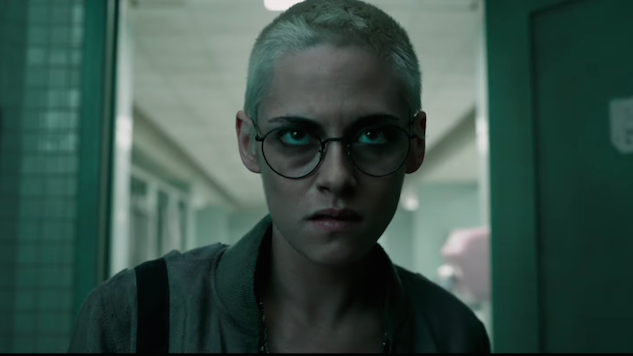
Underwater turned out to be the most unusual type of Lovecraftian adaptation for the 2020s—a film that didn’t advertise itself as one, and instead left the association as a third act reveal of sorts. And even then, this is one of the odder takes on Lovecraft’s arcana, for the simple fact that we don’t usually see this mythology in the context of what is essentially a big budget action/disaster movie. Lovecraftian stories are most typically marked by their intimate settings and most scope—a family under attack, or an obsessed researcher delving into materials he should know better than to explore. Lovecraftian monsters slither into the frame (or linger outside it) with slowly building suspense—they don’t usually topple underwater research stations in a cacophony of explosions and screeching metal. And yet that’s what we have in Underwater, a genuine Lovecraftian monster/disaster movie.
Granted, the giant monster ultimately revealed as the antagonist in Underwater could theoretically have been depicted in any form and the results would have been more or less the same, but when you decide to call that creature “Cthulhu,” you’re officially acknowledging that Lovecraftian fiction has become a marketing tool that has the potential to put at least a few butts in the seats. Ultimately, the psychological themes one expects from most Lovecraftian horror films are pretty much entirely absent, but there’s a great novelty in seeing one of Lovecraft’s Great Old Ones shoehorned into a modern action blockbuster regardless.
The Void
Year: 2016
Directors: Steven Kostanski, Jeremy Gillespie

Viewers should grade writer-directors Steven Kostanski and Jeremy Gillespie’s The Void on a curve: While the low-budget Canadian production earns an “A” for ambition, its mélange of The Thing-inspired body horror, ‘80s nostalgia and Lovecraftian cosmic terror doesn’t quite cohere into a satisfying whole by the time its chief antagonist peels away his skin to reveal a bodysuit that looks like Mighty Morphin Power Rangers’ Lord Zedd. The first half of the film demonstrates much more restraint, building tension as triangle-branded cultists isolate a mismatched group of (mostly) innocent people—led by Aaron Poole as an out-of-his-depth small-town cop—in a (mostly) vacant hospital. Kotanski and Gillespie build in too many potentially conflicting twists—who, exactly, is impregnated with what?—but the grotesque practical effects and descent-into-Hell structure at times pass for a solid Silent Hill adaptation. Some of horror’s most recent, popularly memorable features (say: It Follows, The Babadook) have wisely employed relatively narrow scopes. Instead, The Void attempts to push audiences into another dimension, but manages at least a few successful frights along the way. —Steve Foxe
The Whisperer in Darkness
Year: 2011
Director: Sean Branney
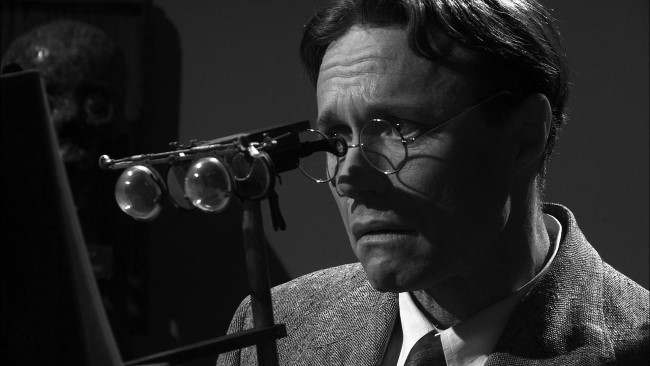
This film, also produced by the H.P. Lovecraft Historical Society, is more or less a spiritual follow-up to their 2005 success with the silent, black-and-white version of The Call of Cthulhu, which had received rave reviews for its fidelity in adapting the classic Lovecraft story in the style in which it likely would have been filmed while he was alive. Whereas The Call of Cthulhu is a tribute to the silent Hollywood horrors of the 1920s, films such as The Cat and the Canary, The Whisperer in Darkness takes into account the sound horror film boom of the 1930s, evoking what a Lovecraft adaptation might have looked like if it was produced in the wake of Dracula and Frankenstein. That essentially makes this film a merging of classic Universal horror tropes with Lovecraft’s pioneering brand of weird science fiction, which is particularly represented in this story. The story introduces one of Lovecraft’s stranger alien races, the interstellar Mi-Go, who fly through space on giant wings and commune with still stranger deities. The black and white, “Mythoscope” gimmick perhaps isn’t quite as fresh here as it was in the preceding Call of Cthulhu, but The Whisperer in Darkness manages to be well shot on its tiny budget, and obviously comes from a place of tremendous passion for Lovecraft’s mythology.
Jim Vorel is Paste’s resident horror guru. You can follow him on Twitter for much more film content.
